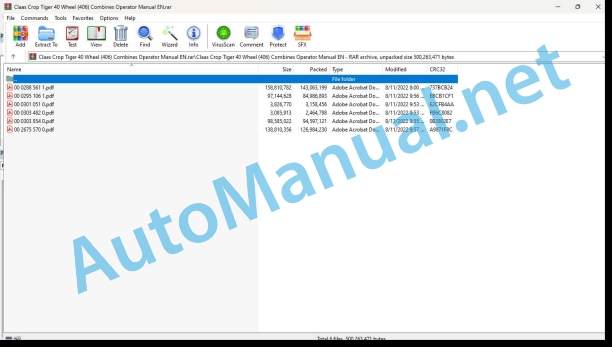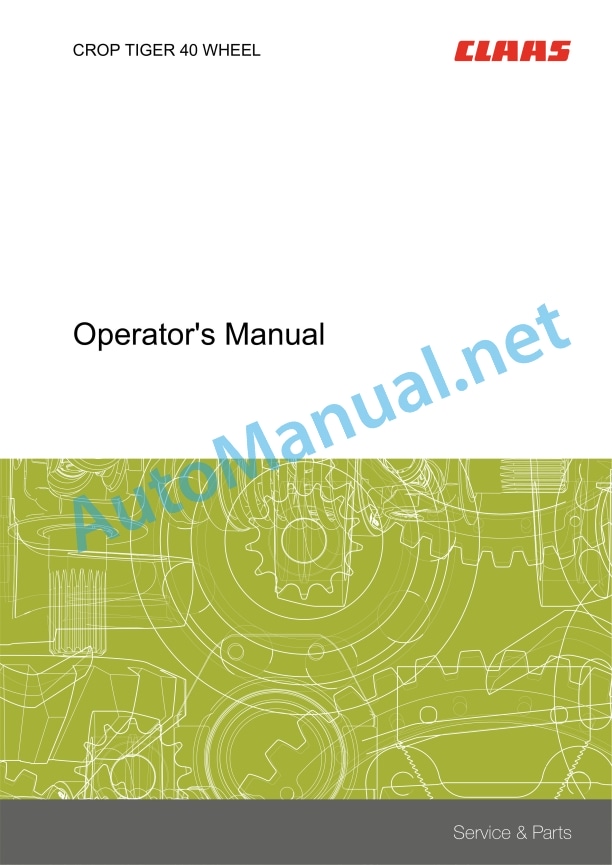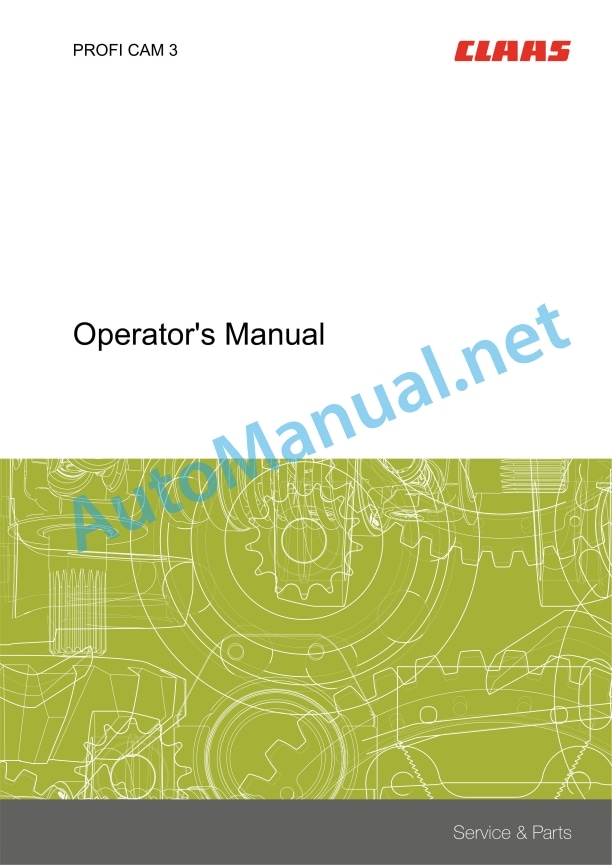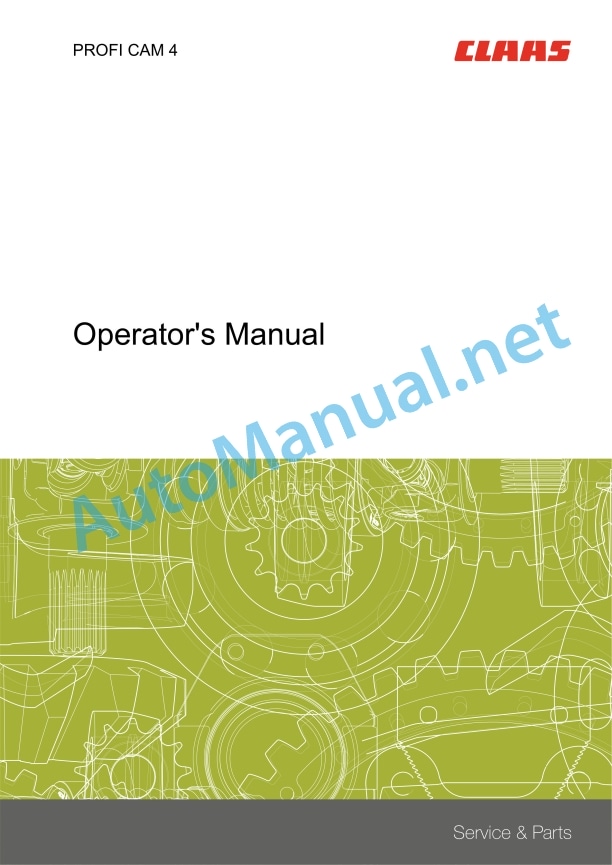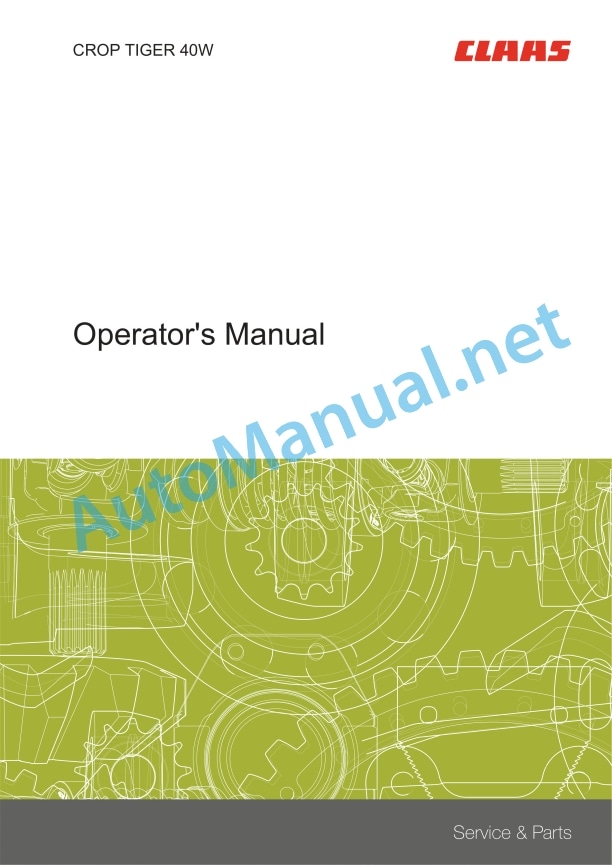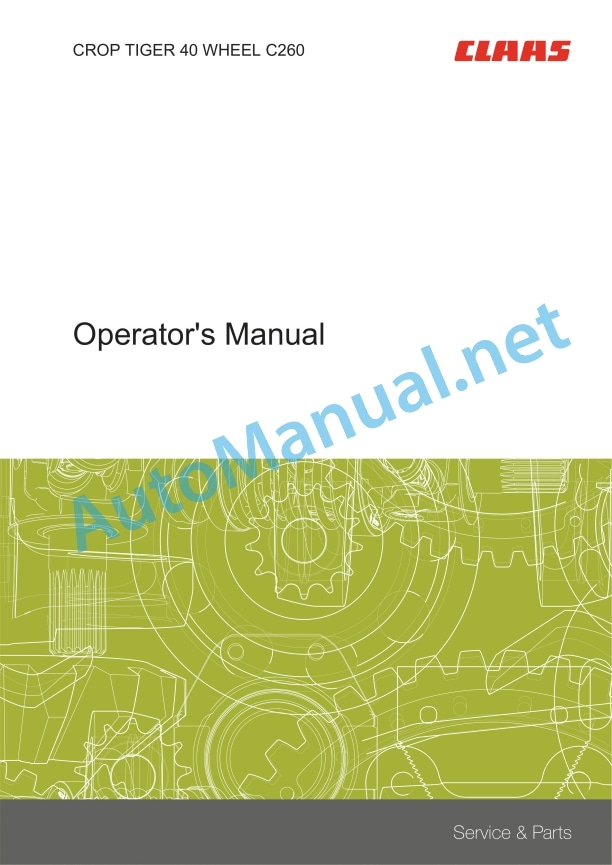Claas Crop Tiger 40 Wheel (406) Combines Operator Manual EN
$50.00
- Model: Crop Tiger 40 Wheel (406) Combines
- Type Of Manual: Operator Manual
- Language: EN
- Format: PDF(s)
- Size: 434 MB
File List:
00 0288 561 1.pdf
00 0295 106 1.pdf
00 0301 051 0.pdf
00 0303 482 0.pdf
00 0303 854 0.pdf
00 2675 570 0.pdf
00 0288 561 1.pdf:
CROP TIGER 40 M460
Table of contents
1 To this Operator’s Manual
1.1 Notes on the manual
1.1.1 Validity of manual
1.1.2 How to use the Manual
1.1.3 Symbols and notes
1.1.4 Technical data
2 Safety
2.1 Safety rules
2.1.1 Intended use
2.1.2 Reasonably foreseeable misuse
2.1.3 Operator’s Manual and other sources of information
Meaning of Operator’s Manual
2.1.4 Personnel qualification and organization
Requirements made on all persons working with the machine
2.1.5 Hazard for children
Children in danger
2.1.6 Fitting / hitching
Fitting a front attachment or hitching a trailer to the machine
2.1.7 Modifications on the machine
Structural modifications
2.1.8 Additional equipment and spare parts
Additional equipment and spare parts
2.1.9 Workplace and persons travelling on the machine
Control of running machine
2.1.10 Technically flawless condition
Operation only following proper pre-delivery inspection
Operation only following proper putting into operation
Technically flawless condition of machine
Danger from damage on the machine
Respecting technical limit values
2.1.11 Hazard areas
Hazard areas
Standing between machine and front attachment
Objects flying away
Hazard while drive is engaged
Risk of injury on the universal drive shaft
Hazard from machine parts that continue rotating
2.1.12 Safety devices
Keeping the safety devices functional
2.1.13 Personal protective equipment
Personal protective equipment
Wearing suitable clothing
2.1.14 Safety markings
Keeping safety decals legible
2.1.15 Road safety
Hazards when driving on the road and on the field
Danger of tipping
Preparing the machine for road travel
Parking the machine safely
Unsupervised parking
Keeping the machine free of foreign objects
2.1.16 Operating utilities
Unsuitable operating utilities
Safe handling of operating and auxiliary utilities
Fuel is hazardous to your health
Environmental protection and disposal
2.1.17 Hazards caused by the field environment
Fire hazard
Possibly lethal electrocution from overhead lines
Behaviour in case of voltage flash-over of overhead lines and in case of lightning strike
2.1.18 Hazard sources on the machine
Electrocution from electric system
Noise may cause health problems
Vibrations may cause health problems
Liquids under pressure
Toxic exhaust gas
Hot surfaces
2.1.19 Hazard when climbing on and leaving the machine
Safe climbing on and leaving the machine
2.1.20 Hazards when working on the machine
Working on machine only after shutting it down
Maintenance and repair work
Lifted machine parts and loads
Danger from welding work
2.1.21 Checking the battery
Checking and charging the battery
2.1.22 Identification of warning and danger signs
2.2 Safety decals on the machine
2.2.1 General information on safety decals
2.2.2 Engine
2.2.3 Chassis
2.2.4 Operator’s platform
2.2.5 Feeder Unit
2.2.6 Threshing mechanism
2.2.7 Crop receptacle / straw receptacle
2.2.8 Grain Delivery
2.2.9 Drives
2.3 Safety devices
2.3.1 Applying the feed rake conveyor safety lock
2.3.2 Releasing the feed rake conveyor safety lock
2.3.3 Securing the machine against rolling away
2.3.4 Battery isolating switch
2.3.5 Checking the fire extinguisher
3 Machine description
3.1 Overview and method of operation
3.1.1 Overview of front and left side of machine
3.1.2 Overview of rear and right side of machine
3.1.3 Working mode of the machine
3.1.4 Function of machine
3.1.5 Engine overview TATA 497 TC 48
3.1.6 Overview of cooling units
3.2 Identification plates and vehicle identification number
3.2.1 Spare parts and technical questions
3.2.2 Engine identification plate on TATA 497 TC 48 / 99 diesel engine
3.2.3 Machine identification plate
Identification plate.
4 Operating and control elements
4.1 Cab and operator’s platform
4.1.1 Overview of operator’s platform
4.1.2 Switch console
4.1.3 Drive lights, work lights, mirrors
4.1.4 Lever for adjusting the diesel engine speed
4.1.5 Ignition switch
4.1.6 Ground speed control lever
4.1.7 Adjusting the driver’s seat
5 Technical specifications
5.1 CROP TIGER 40 M460
5.1.1 General instructions
5.1.2 Engine
5.1.3 Chassis
5.1.4 Tyre Pressure
5.1.5 Chassis wheel tread
5.1.6 Brake
5.1.7 Steering
5.1.8 Electrical / electronic equipment
5.1.9 Drives
5.1.10 Feeder unit
5.1.11 Threshing mechanism and separation
5.1.12 Cleaning unit
5.1.13 Grain delivery
5.1.14 Attachment parts / machine body dimensions
5.1.15 Attachment parts / machine body weights
6 Machine preparation
6.1 Shutting down and securing the machine
6.1.1 Stopping and secure the machine
6.2 Access to workplace and maintenance positions
6.2.1 Access to the workplace and maintenance areas
6.3 Prior to operation
6.3.1 Prior to initial operation
6.3.2 Prior to every operation
6.4 Adjusting the machine
6.4.1 Setting the machine to corn harvest
6.4.2 Using a machine fitted with multicrop equipment
6.4.3 Threshing chart
6.4.4 Cleaning the machine prior to a change of seeds
6.5 Front attachment
6.5.1 Installing the front attachment
6.5.2 Hitching the front attachment
6.5.3 Locking the front attachment
6.5.4 Installing the universal drive shaft
6.5.5 Removing the front attachment
6.5.6 Removing the universal drive shaft
6.5.7 Unlocking the front attachment
6.6 Engine
6.6.1 Refuelling the machine
6.7 Chassis
6.7.1 Removing and installing the wheels
6.7.2 Jacking up the machine
Jacking up the machine beneath the axles
6.8 Brake
6.8.1 Checking the parking brake
6.8.2 Checking the foot brake
6.9 Hydraulic system
6.9.1 Identifying the hydraulic oil
6.10 Operator’s platform
6.10.1 Installing rear view mirrors
6.11 Electrical and electronic system
6.11.1 Checking the back-up horn
6.12 Feeder unit
6.12.1 Adjusting the feeder chains
6.12.2 Adjusting the feeder chain height
6.13 Threshing mechanism
6.13.1 Installing / removing the stone trap and feed plate
6.13.2 Removing the threshing concave
6.13.3 Threshing concave variants
6.13.4 Installing the threshing concave
6.13.5 Adjusting the distance of the threshing concave
6.14 Cleaning system
6.14.1 Basic adjustment of the sieves
6.15 Grain delivery
6.15.1 Entering / leaving the grain tank
6.15.2 Open / close grain tank cover
6.16 Electrical and electronic system
6.16.1 Opening / closing the side panels
6.16.2 Opening / closing the rear cover
6.16.3 Checking the reverse warning horn
7 Operation
7.1 Driving the machine
7.1.1 Preparing road travel
7.1.2 Preparing fieldwork
7.1.3 Driving the machine with the ground speed control lever
Reducing the ground speed
Increasing the ground speed
Braking the machine
Stopping the machine
Driving backward
7.2 Engine
7.2.1 Setting the diesel engine speed
7.2.2 Start the diesel engine
Let the diesel engine warm up if the outside temperature is below 0 C.
If the outside temperature is below -10 C, let the diesel engine and the hydraulic system warm up.
7.2.3 Stop the diesel engine
7.3 Chassis
7.3.1 Shifting gears
7.3.2 Driving properties
7.3.3 Towing the machine
7.3.4 Towing forward
7.3.5 Towing in reverse
7.4 Brake
7.4.1 Engaging the parking brake
7.4.2 Releasing the parking brake
7.4.3 Foot brake
7.4.4 Parking the machine
7.5 Steering
7.5.1 Steering
7.6 Cab and latform
7.6.1 Adjusting the driver’s seat
7.7 Feeder unit
7.7.1 Engaging the feed rake conveyor
7.7.2 Disengaging the feed rake conveyor
7.8 Threshing mechanism
7.8.1 Engage the threshing mechanism
7.8.2 Disengage the threshing mechanism
7.8.3 Removing the threshing rotor
7.8.4 Installing the threshing rotor
7.8.5 Converting the threshing rotor to rice harvesting
7.8.6 Converting the threshing rotor to grain harvesting*
7.8.7 Threshing concave variants
7.8.8 Installing the disawning bars (additional equipment)
7.8.9 Unwrapping the threshing rotor
7.8.10 Adjusting the threshing rotor speed
7.9 Cleaning system
7.9.1 Adjusting the sieve
7.9.2 Adjusting the fan speed
7.9.3 Adjusting the fan blast reduction
7.10 Grain delivery
7.10.1 Opening and closing the grain tank cover
7.10.2 Swinging the grain tank unloading tube out and in
7.10.3 Engaging and disengaging grain tank unloading
8 Faults and remedies
8.1 Engine
8.1.1 Diesel engine
8.1.2 Draining the fuel from the fuel tank
8.1.3 Bleeding the fuel system
8.1.4 Diesel engine problems and remedies
8.1.5 Assist-starting
Starting the diesel engine
8.2 Electrical and electronic system
8.2.1 Opening the basic central terminal compartment
8.2.2 Closing the basic central terminal compartment
8.2.3 Basic central terminal compartment
8.3 Front attachment
8.3.1 Front attachment fault and remedy
8.4 Feeder unit
8.4.1 Problems with and remedies for the feed rake conveyor
8.5 Threshing mechanism
8.5.1 Problems with and remedies for the threshing mechanism
8.5.2 Threshing rotor
8.6 Separation
8.6.1 Problems with and remedies for the separation
8.7 Cleaning system
8.7.1 Problems with and remedies for the cleaning system
8.8 Grain delivery
8.8.1 Problems with and remedies for grain delivery
9 Maintenance
9.1 General information
9.1.1 General maintenance warnings
9.1.2 Diesel engine
9.1.3 Cleaning the engine compartment and hazard areas
9.1.4 Belts
9.1.5 Variable-speed drives
9.1.6 Proper chain tension
9.1.7 Bolts
9.1.8 Lubrication
9.1.9 Cleanness of lubricants
9.1.10 Brake
9.1.11 Wheels / tyres
9.1.12 Hydraulic system
9.1.13 Electric system
9.1.14 Protective guards
9.1.15 Spare parts
9.1.16 Unbalance
9.1.17 Welding work on combine harvester
9.1.18 Cleaning of surfaces with decals
9.1.19 Storing the machine
9.1.20 Coolant
9.1.21 Preventing fire and explosion
9.2 Operating utilities
9.2.1 Lubricants
9.3 Service intervals
9.3.1 Handling of maintenance intervals
9.3.2 Before the harvest
9.3.3 After the first 10 operating hours
9.3.4 After the first 50 operating hours
9.3.5 After the first 100 operating hours
9.3.6 After the first 500 operating hours
9.3.7 Every 10 operating hours or daily
9.3.8 Every 50 operating hours
9.3.9 Every 100 operating hours
9.3.10 Every 250 operating hours
9.3.11 Every 500 operating hours or annually
9.3.12 Every 2 years
9.3.13 Every 5 years
9.3.14 After the harvest
9.4 Engine
9.4.1 Cleaning the diesel engine surroundings
9.4.2 Replacing the fuel filter
9.4.3 Checking the diesel engine oil level
9.4.4 Changing the diesel engine oil / oil filter
9.4.5 Checking the radiator coolant level
9.4.6 Checking the coolant mixing ratio
9.4.7 Changing the radiator coolant
9.4.8 Draining the radiator coolant
9.4.9 Topping up radiator coolant
9.4.10 Preparing the air gun for cleaning the cooling units
9.4.11 Cleaning the radiator screen
9.4.12 Cleaning the cooling unit
9.4.13 Changing the coolant hoses
9.4.14 Cleaning / changing the diesel engine air filter
9.4.15 Changing the diesel engine air filter safety filter element
9.4.16 Cleaning the air intake filter
9.4.17 Changing the air intake hoses
9.4.18 Retightening the air intake hose clamps
9.5 Chassis
9.5.1 Wheels / tyres
9.5.2 Checking the tightening torque of wheel nuts / wheel bolts
9.5.3 Cleaning the surroundings drive axle manual gearbox
9.5.4 Checking the axle drive oil level
9.5.5 Draining the axle drive oil
9.5.6 Topping up the axle drive oil
9.5.7 Checking the drive axle manual gearbox oil level
9.5.8 Draining the drive axle manual gearbox oil
9.5.9 Topping up the drive axle manual gearbox oil
9.6 Brake
9.6.1 Checking the brake fluid level
9.6.2 Checking the brake shoes
9.7 Drives
9.7.1 Drive diagram left side CROP TIGER 40 M460
9.7.2 Drive diagram right side CROP TIGER 40 M460
9.7.3 Removing belt (R1)
9.7.4 Fitting belt (R1)
9.7.5 Adjusting belt (R1)
9.7.6 Removing chain (K2)
9.7.7 Fitting and adjusting chain (K2)
9.7.8 Removing belt (R3)
9.7.9 Fitting belt (R3)
9.7.10 Adjusting belt (R3)
9.7.11 Removing belt (R4)
9.7.12 Fitting belt (R4)
9.7.13 Adjusting belt (R4)
9.7.14 Removing belt (R5)
9.7.15 Fitting and adjusting belt (R5)
9.7.16 Removing belt (R6)
9.7.17 Fitting and adjusting belt (R6)
9.7.18 Removing belt (R7)
9.7.19 Fitting belt (R7)
9.7.20 Adjusting belt (R7)
9.7.21 Removing belt (R8)
9.7.22 Fitting belt (R8)
9.7.23 Adjusting belt (R8)
9.7.24 Removing belt (R9)
9.7.25 Fitting belt (R9)
9.7.26 Removing chain (K10)
9.7.27 Fitting and adjusting chain (K10)
9.7.28 Removing belt (R11)
9.7.29 Fitting and adjusting belt (R11)
9.7.30 Removing belt (R11)
9.7.31 Fitting and adjusting belt (R11)
9.7.32 Removing chain (K12)
9.7.33 Fitting and adjusting chain (K12)
9.7.34 Removing belt (R13)
9.7.35 Adjusting belt (R13)
9.7.36 Removing belt (R14)
9.7.37 Adjusting belt (R14)
9.7.38 Removing belt (R15)
9.7.39 Adjusting belt (R15)
9.8 Hydraulic system
9.8.1 Relieving the pressure accumulator
9.8.2 Checking the hydraulic system oil level
9.8.3 Changing the hydraulic system oil / oil filter
9.9 Electrical / Electronic equipment
9.9.1 Disconnecting the battery isolating switch
9.9.2 Checking the battery electrolyte level
9.10 Feeder unit
9.10.1 Adjusting the feeder chains
9.11 Grain delivery
9.11.1 Adjusting the returns elevator chain
9.11.2 Adjusting the grain elevator chain
9.11.3 Clean the auger troughs
9.11.4 Clean the grain tank
9.11.5 Checking the grain tank unloading tube transport position
9.12 Various components and machine body
9.12.1 Checking the fire extinguisher
9.12.2 Check if machine is soiled.
Cleaning the sieves
9.12.3 Compressed-air cleaning system
9.12.4 Checking the hydraulic system for leaks
9.12.5 Checking the gearbox for leaks
9.13 Lubrication chart
9.13.1 Lubrication points – 10 h left
9.13.2 Lubrication points – 50 h left
9.13.3 Lubrication points – 100 h left
9.13.4 Lubrication points – 10 h right
9.13.5 Lubrication points – 50 h right
9.13.6 Lubrication points – 100 h right
9.13.7 Lubrication points – 500h right
10 Placing out of operation and disposal
10.1 General information
10.1.1 Putting out of operation and disposal
00 0295 106 1.pdf:
CROP TIGER 40 WHEEL
Table of contents
1 To this Operator’s Manual
1.1 Notes on the manual
1.1.1 Validity of manual
1.1.2 How to use the Manual
1.1.3 Symbols and notes
1.1.4 Technical data
2 Safety
2.1 Safety rules
2.1.1 General safety warnings
2.1.2 General instructions
2.1.3 Important!
2.1.4 Intended use
2.1.5 Reasonably foreseeable misuse
2.1.6 Safety and accident prevention regulations for combine-harvesters
2.1.7 Prior to putting into operation, general
2.1.8 Identification of warning and danger signs
2.1.9 Road traffic
2.1.10 General driving operation
2.1.11 Combine harvester driving operation
2.1.12 Driving on slopes
2.1.13 Transporting persons
2.1.14 Leaving the machine
2.1.15 Diesel engine
2.1.16 Hints regarding the diesel engine
2.1.17 Anti-freeze
2.1.18 Risk of injury by hydraulic liquid
2.1.19 Front attachments and trailers
2.1.20 Grain delivery
2.1.21 Accumulator
2.1.22 Adjusting and maintenance work
2.1.23 First aid measures
2.2 Safety decals on the machine
2.2.1 General information on safety decals
2.2.2 Front attachment
2.2.3 Engine
2.2.4 Chassis
2.2.5 Operator’s platform
2.2.6 Feeder Unit
2.2.7 Threshing mechanism
2.2.8 Crop receptacle / straw receptacle
2.2.9 Grain Delivery
2.3 Safety devices
2.3.1 Applying the feed rake conveyor safety lock
2.3.2 Removing the feed rake conveyor safety lock
2.3.3 Securing the machine against rolling away
2.3.4 Battery isolating switch
2.3.5 Attaching finger bar safety bar
3 Machine description
3.1 Overview and method of operation
3.1.1 Overview of front and left side of machine
3.1.2 Overview of rear and right side of machine
3.1.3 Overview of front attachment
3.1.4 Transport trailer
3.1.5 Working mode of the machine
3.1.6 Function of the machine
3.1.7 Engine overview TATA 497 TC 48
3.1.8 Overview of cooling units
3.2 Identification plates and vehicle identification number
3.2.1 Spare parts and technical questions
3.2.2 Engine identification plate TATA 497 TC 48
3.2.3 Position of identification plates
4 Operating and control elements
4.1 Cab / Operator’s platform
4.1.1 Overview of operator’s platform
4.1.2 Switch console
4.1.3 Drive lights, work lights, mirrors
4.1.4 Ignition switch
4.1.5 Ground speed control lever
4.1.6 Adjusting the driver’s seat
5 Technical specifications
5.1 CROP TIGER 40 – type 406
5.1.1 General instructions
5.1.2 Front attachment
5.1.3 Engine
5.1.4 Chassis
5.1.5 Chassis wheel tread
5.1.6 Brake
5.1.7 Tyre Pressure
5.1.8 Steering
5.1.9 Drives
5.1.10 Electrical / electronic equipment
5.1.11 Feeder unit
5.1.12 Threshing mechanism
5.1.13 Separation
5.1.14 Cleaning unit
5.1.15 Grain delivery
5.1.16 Attachment parts/machine body dimensions
5.1.17 Trailer dimensions
5.1.18 Attachment parts/ machine body weights
6 Machine preparation
6.1 Switching off and securing the machine
6.1.1 Switch off and secure the machine
6.2 Prior to operation
6.2.1 Prior to initial operation
6.2.2 Prior to every operation
6.3 Adjusting the machine
6.3.1 Adjusting the machine for the rice harvest*
6.3.2 Adjusting the machine for multicrop harvest
6.3.3 Using a machine fitted with multicrop equipment
6.3.4 Threshing chart
6.3.5 Cleaning the machine prior to a change of seeds
6.4 Loading the machine
6.4.1 Loading and lashing down the machine
6.4.2 Loading and tying-down of transport trailer
6.5 Front attachment
6.5.1 Installing the front attachment
6.5.2 Interlocking the front attachment
6.5.3 Installing universal drive shaft
6.5.4 Mounting the coupler
6.5.5 Removing the stands
6.5.6 Removing the front attachment
6.5.7 Fitting the stands
6.5.8 Dismounting the coupler
6.5.9 Removing universal drive shaft
6.5.10 Unlocking the front attachment
6.6 Engine
6.6.1 Refuelling the machine
6.7 Chassis
6.7.1 Removing / installing the wheels
6.7.2 Jacking up the machine
6.8 Brake
6.8.1 Checking the parking brake
6.8.2 Checking the foot brake
6.9 Hitch
6.9.1 Hitching a trailer
6.9.2 Unhitching the trailer
6.10 Electrical / Electronic equipment
6.10.1 Checking the back-up horn
6.11 Feeder unit
6.11.1 Adjusting the feeder chains
6.12 Threshing mechanism
6.12.1 Installing / removing the stone trap and feed plate
6.12.2 Removing the threshing concave
6.12.3 Threshing concave variants
6.12.4 Installing the threshing concave
6.12.5 Adjusting the distance of the threshing concave
6.13 Cleaning system
6.13.1 Basic Adjustment of the sieves
6.14 Grain delivery
6.14.1 Entering / leaving the grain tank
6.14.2 Open / close grain tank cover
6.15 Various components / Machine body
6.15.1 Opening / closing the side panels
7 Operation
7.1 Driving the machine
7.1.1 Preparing road travel
7.1.2 Preparing fieldwork
7.1.3 Driving the machine with the ground speed control lever
Reducing the ground speed
Increasing the ground speed
Braking the machine
Stopping the machine
Driving backward
7.2 Engine
7.2.1 Setting the diesel engine speed
7.2.2 Start the diesel engine
7.2.3 Stop the diesel engine
7.3 Chassis
7.3.1 Shifting gears
7.3.2 Driving properties
7.3.3 Towing the machine
7.3.4 Towing forward
7.3.5 Towing in reverse
7.4 Grain harvest
7.4.1 Fitting the crop dividers
7.5 Brake
7.5.1 Engaging the parking brake
7.5.2 Releasing the parking brake
7.5.3 Foot brake
7.5.4 Parking the machine
7.6 Steering
7.6.1 Steering
7.7 Cab / Operator’s platform
7.7.1 Adjusting the driver’s seat
7.8 Mower unit
7.8.1 Removing crop lifters
7.8.2 Adjusting the skid
7.8.3 Installing crop lifters
7.8.4 Adjusting knife clips
7.9 Crop feeding
7.9.1 Adjusting the reel tines
7.9.2 Making the horizontal reel adjustment
7.9.3 Adjusting the stripper profile of the intake auger
7.9.4 Adjusting the position of the intake auger
7.9.5 Adjusting the intake auger fingers
7.9.6 Adjusting the reel peripheral speed
7.10 Feeder unit
7.10.1 Engaging the feed rake conveyor
7.10.2 Disengaging the feed rake conveyor
7.11 Threshing mechanism
7.11.1 Engage the threshing mechanism
7.11.2 Disengage the threshing mechanism
7.11.3 Removing the threshing rotor
7.11.4 Installing the threshing rotor
7.11.5 Converting the threshing rotor to rice harvesting
7.11.6 Converting the threshing rotor to grain harvesting
7.11.7 Threshing concave variants
7.11.8 Threshing rotor variants
7.11.9 Installing the disawning bars (additional equipment)
7.11.10 Unwrapping the threshing rotor
7.11.11 Adjusting the threshing rotor speed
7.12 Cleaning system
7.12.1 Adjusting the sieve
7.12.2 Adjusting the fan speed
7.12.3 Adjusting the fan blast reduction
7.13 Grain delivery
7.13.1 Swinging the grain tank unloading tube out / in
7.13.2 Engaging / disengaging grain tank unloading
7.14 Loading the front attachment
7.14.1 Laying on the front attachment
7.14.2 Lifting off the front attachment
8 Faults and remedies
8.1 Engine
8.1.1 Diesel engine
8.1.2 Draining the fuel from the fuel tank
8.1.3 Bleeding the fuel system
8.1.4 Diesel engine problems and remedies
8.2 Electrical / Electronic equipment
8.2.1 Opening the basic central terminal compartment
8.2.2 Closing the basic central terminal compartment
8.2.3 Basic central terminal compartment
8.3 Front attachment
8.3.1 Front attachment fault and remedy
8.3.2 Fault and remedy for transport trailer
8.4 Feeder unit
8.4.1 Problems with and remedies for the feed rake conveyor
8.5 Threshing mechanism
8.5.1 Problems with and remedies for the threshing mechanism
8.5.2 Threshing rotor
8.6 Separation
8.6.1 Problems with and remedies for the separation
8.7 Cleaning system
8.7.1 Problems with and remedies for the cleaning system
8.8 Grain delivery
8.8.1 Problems with and remedies for grain delivery
9 Maintenance
9.1 General information
9.1.1 Diesel engine
9.1.2 Cleaning the engine compartment and hazard areas
9.1.3 Front attachment
9.1.4 Belts
9.1.5 Variable-speed drives
9.1.6 Correct chain tension
9.1.7 Bolts
9.1.8 Lubrication
9.1.9 Cleanness of lubricants
9.1.10 Brake
9.1.11 Wheels / tyres
9.1.12 Hydraulic system
9.1.13 Electric system
9.1.14 Welding work on combine harvester
9.1.15 Cleaning of surfaces with decals
9.1.16 Winter storage suggestions for combine harvesters
9.1.17 Coolant
9.1.18 Preventing fire and explosion
9.2 Operating utilities
9.2.1 Lubricants
9.3 Maintenance intervals
9.3.1 Handling of maintenance intervals
9.3.2 Before the harvest
9.3.3 After the first 10 operating hours
9.3.4 After the first 50 operating hours
9.3.5 After the first 100 operating hours
9.3.6 After the first 500 operating hours
9.3.7 Every 10 operating hours or daily
9.3.8 Every 50 operating hours
9.3.9 Every 100 operating hours
9.3.10 Every 250 operating hours
9.3.11 Every 500 operating hours or annually
9.3.12 Every 2 years
9.3.13 Every 5 years
9.3.14 After the harvest
9.4 Engine
9.4.1 Cleaning the diesel engine surroundings
9.4.2 Replacing the fuel filter
9.4.3 Checking the diesel engine oil level
9.4.4 Changing the diesel engine oil / oil filter
9.4.5 Checking the radiator coolant level
9.4.6 Checking the coolant mixing ratio
9.4.7 Changing the radiator coolant
9.4.8 Draining the radiator coolant
9.4.9 Topping up radiator coolant
9.4.10 Cleaning the radiator screen
9.4.11 Cleaning the cooling unit
9.4.12 Changing the coolant hoses
9.4.13 Cleaning / changing the diesel engine air filter
9.4.14 Changing the diesel engine air filter safety filter element
9.4.15 Cleaning the air intake filter
9.4.16 Changing the air intake hoses
9.4.17 Retightening the air intake hose clamps
9.5 Chassis
9.5.1 Wheels / tyres
9.5.2 Cleaning the surroundings of drive axle manual gearbox
9.5.3 Checking the tightening torque of wheel nuts / wheel bolts
9.5.4 Checking the axle drive oil level
9.5.5 Draining the axle drive oil
9.5.6 Topping up the axle drive oil
9.5.7 Checking the drive axle manual gearbox oil level
9.5.8 Draining the drive axle manual gearbox oil
9.5.9 Topping up the drive axle manual gearbox oil
9.6 Brake
9.6.1 Checking the brake fluid level
9.7 Drives
9.7.1 Drive diagram left side CROP TIGER 40 WHEEL
9.7.2 Drive diagram right side CROP TIGER 40 WHEEL
9.7.3 Removing chain (K1)
9.7.4 Fitting and adjusting chain (K1)
9.7.5 Fitting and Adjusting chain (K2)
9.7.6 Removing belt (R3)
9.7.7 Fitting and adjusting belt (R3)
9.7.8 Removing chain (K4)
9.7.9 Fitting and adjusting chain (K4)
9.7.10 Adjusting belt (R5)
9.7.11 Adjusting belt (R6)
9.7.12 Adjusting belt (R7)
9.7.13 Removing belt (R10)
9.7.14 Fitting belt (R10)
9.7.15 Adjusting belt (R10)
9.7.16 Removing chain (K11)
9.7.17 Fitting and adjusting chain (K11)
9.7.18 Removing belt (R12)
9.7.19 Fitting belt (R12)
9.7.20 Adjusting belt (R12)
9.7.21 Removing belt (R13)
9.7.22 Fitting belt (R13)
9.7.23 Adjusting belt (R13)
9.7.24 Removing belt (R14)
9.7.25 Fitting and adjusting belt (R14)
9.7.26 Removing belt (R15)
9.7.27 Fitting and adjusting belt (R15)
9.7.28 Removing belt (R16)
9.7.29 Fitting belt (R16)
9.7.30 Adjusting belt (R16)
9.7.31 Removing belt (R17)
9.7.32 Fitting belt (R17)
9.7.33 Adjusting belt (R17)
9.7.34 Removing belt (R18)
9.7.35 Fitting belt (R18)
9.7.36 Removing chain (K19)
9.7.37 Fitting and adjusting chain (K19)
9.8 Hydraulic system
9.8.1 Relieving the pressure accumulator
9.8.2 Checking the hydraulic system oil level
9.8.3 Changing the hydraulic system oil / oil filter
9.9 Electrical / Electronic equipment
9.9.1 Checking the battery electrolyte level
9.10 Feeder unit
9.10.1 Adjusting the feeder chains
9.10.2 Adjusting the feeder chains’ slip clutch
9.11 Grain delivery
9.11.1 Adjusting the returns elevator chain
9.11.2 Adjusting the grain elevator chain
9.11.3 Clean the auger troughs
9.11.4 Clean the grain tank
9.11.5 Checking the grain tank unloading tube transport position
9.12 Various components / Machine body
9.12.1 Check if machine is soiled.
Cleaning the sieves
9.12.2 Compressed-air cleaning system
9.13 Lubrication plan
9.13.1 Lubrication points – 10 h left
9.13.2 Lubrication points – 50 h left
9.13.3 Lubrication points – 100 h left
9.13.4 Lubrication points – 10 h right
9.13.5 Lubrication points – 50 h right
9.13.6 Lubrication points – 500h right
10 Placing out of operation and disposal
10.1 General information
10.1.1 Putting out of operation and disposal
00 0301 051 0.pdf:
PROFI CAM 3
Table of contents
1 Introduction
1.1 Notes on the manual
1.1.1 Validity of manual
1.1.2 Information about this Operator’s Manual
1.1.3 Symbols and notes
1.1.4 Optional equipment
1.1.5 Qualified specialist workshop
1.1.6 Maintenance information
1.1.7 Warranty notes
1.1.8 Spare parts and technical questions
1.2 Intended use
1.2.1 Intended use
1.2.2 Reasonably foreseeable misuse
2 Safety
2.1 Identifying warnings
2.1.1 Hazard signs
2.1.2 Signal word
2.2 Safety rules
2.2.1 Meaning of Operator’s Manual
2.2.2 Observing safety decals and warnings
2.2.3 Optional equipment and spare parts
3 Product description
3.1 Overview and method of operation
3.1.1 How the PROFI CAM works
3.2 Identification plates and identification number
3.2.1 Position of identification plates
3.2.2 Explanation of PROFI CAM identification plate
3.3 Information on the product
3.3.1 CE marking
4 Operating and control elements
4.1 Camera system
4.1.1 Camera system monitor
4.2 Menu structure
4.2.1 Main menu
4.2.2
4.2.3
4.2.4
4.2.5
4.2.6
5 Technical specifications
5.1 PROFI CAM
5.1.1 Monitor
5.1.2 Camera
5.1.3 Switch box
5.1.4 Degree of protection against foreign bodies and water
6 Preparing the product
6.1 Shutting down and securing the machine
6.1.1 Switching off and securing the machine
6.2 Prior to operation
6.2.1 Carry out prior to operation
6.2.2 Installing the sun protection
6.2.3 Aligning the camera
6.2.4 Connecting the camera electrics
7 Operation
7.1 Monitor
7.1.1 Switching on the monitor
7.1.2 Calling up the menu
7.1.3 Setting a menu item
7.1.4 Setting the image orientation
7.1.5 Setting automatic screen darkening
7.1.6 Image mirroring
7.1.7 Setting the trigger view
7.1.8 Setting the follow-up time for trigger view
7.1.9 Setting the display mode
7.1.10 Activating/deactivating a display mode
8 Faults and remedies
8.1 Electrical and electronic system
8.1.1 Overview of problems on PROFI CAM camera system
8.1.2 Replacing the switch box fuse
9 Maintenance
9.1 Maintenance intervals
9.1.1 Every 10 operating hours or daily
9.2 Camera system
9.2.1 Checking the camera system for dirt
9.2.2 Cleaning the camera
9.2.3 Cleaning the switch box
9.2.4 Cleaning the monitor
10 Placing out of operation and disposal
10.1 General Information
10.1.1 Putting out of operation and disposal
11 Technical terms and abbreviations
11.1 Abbreviations
11.1.1 Units
11.1.2 Abbreviations
11.1.3 Technical terms
00 0303 482 0.pdf:
PROFI CAM 4
Table of contents
1 Introduction
1.1 Notes on the manual
1.1.1 Validity of manual
1.1.2 Information about this Operator’s Manual
1.1.3 Symbols and notes
1.1.4 Optional equipment
1.1.5 Qualified specialist workshop
1.1.6 Maintenance information
1.1.7 Notes on warranty
1.1.8 Spare parts and technical questions
1.2 Intended use
1.2.1 Intended use
1.2.2 Reasonably foreseeable misuse
2 Safety
2.1 Identifying warnings
2.1.1 Hazard signs
2.1.2 Signal word
2.2 Safety rules
2.2.1 Meaning of Operator’s Manual
2.2.2 Structural changes
2.2.3 Optional equipment and spare parts
2.2.4 Operation only following proper putting into operation
John Deere Repair Technical Manual PDF
John Deere POWERTECH E 4.5 and 6.8 L Diesel Engines TECHNICAL MANUAL 25JAN08
John Deere Repair Technical Manual PDF
John Deere 18-Speed PST Repair Manual Component Technical Manual CTM168 10DEC07
John Deere Repair Technical Manual PDF
John Deere Parts Catalog PDF
John Deere Harvesters 8500 and 8700 Parts Catalog CPCQ24910 Spanish
John Deere Repair Technical Manual PDF
John Deere PowerTech M 10.5 L and 12.5 L Diesel Engines COMPONENT TECHNICAL MANUAL CTM100 10MAY11
John Deere Repair Technical Manual PDF
John Deere Repair Technical Manual PDF
John Deere Repair Technical Manual PDF

